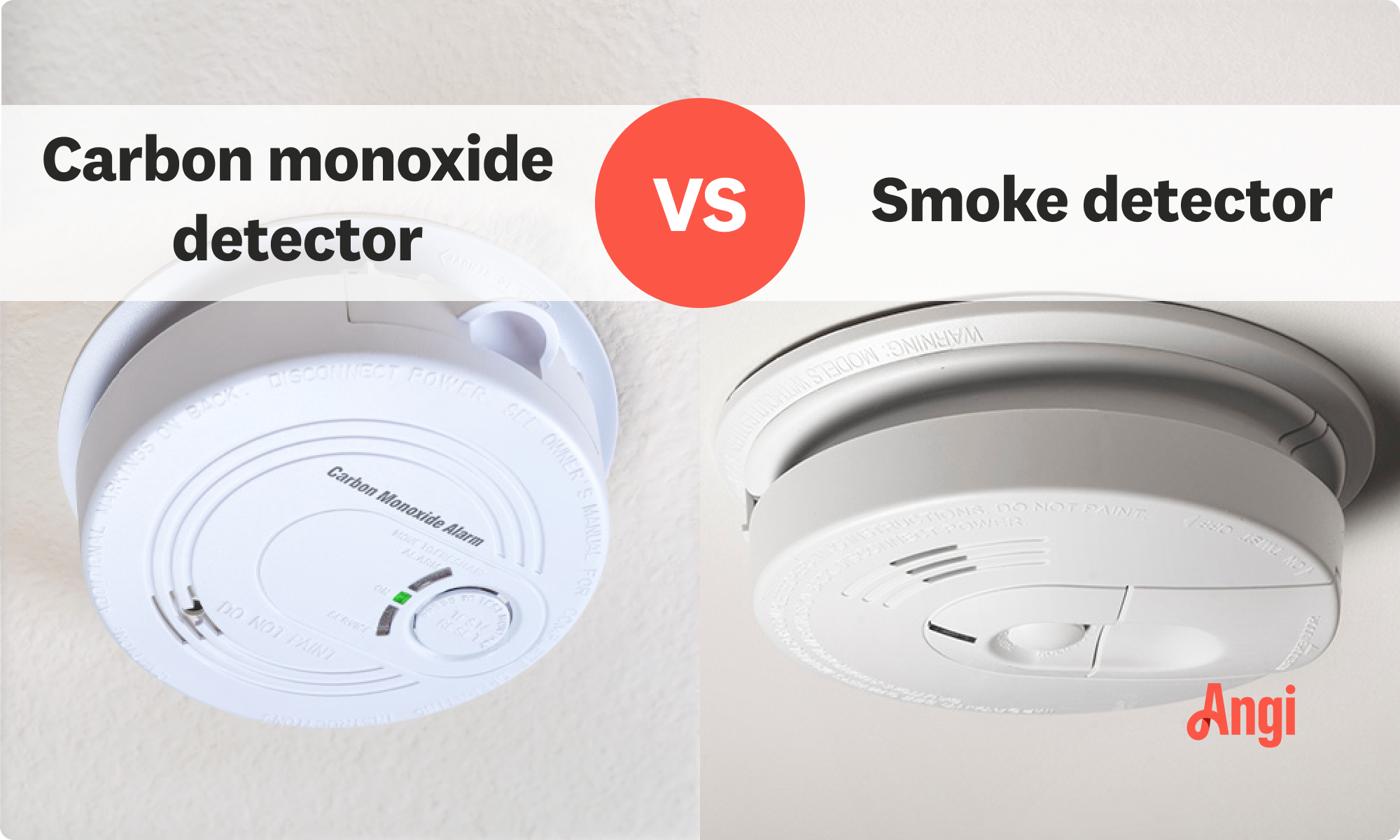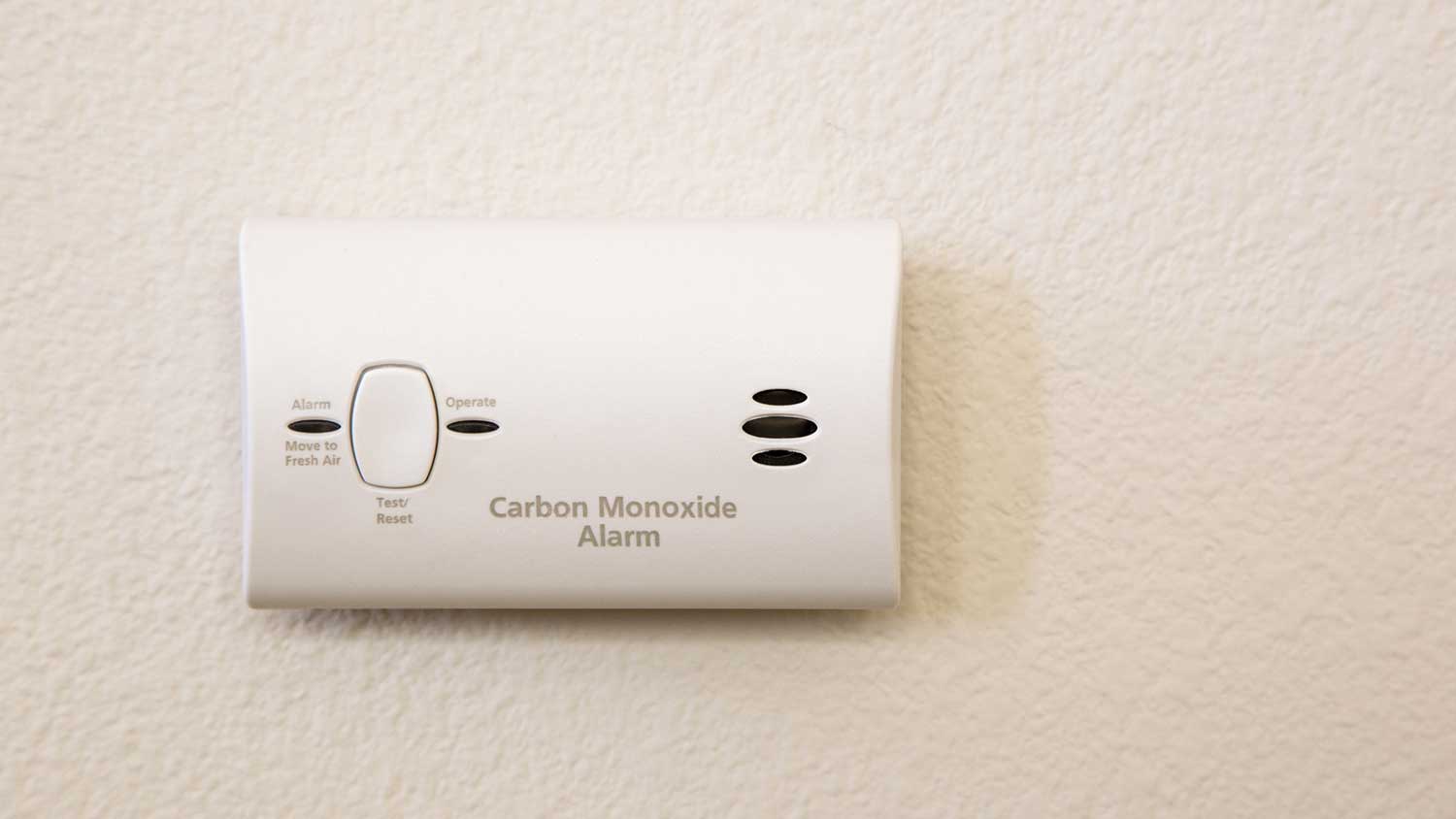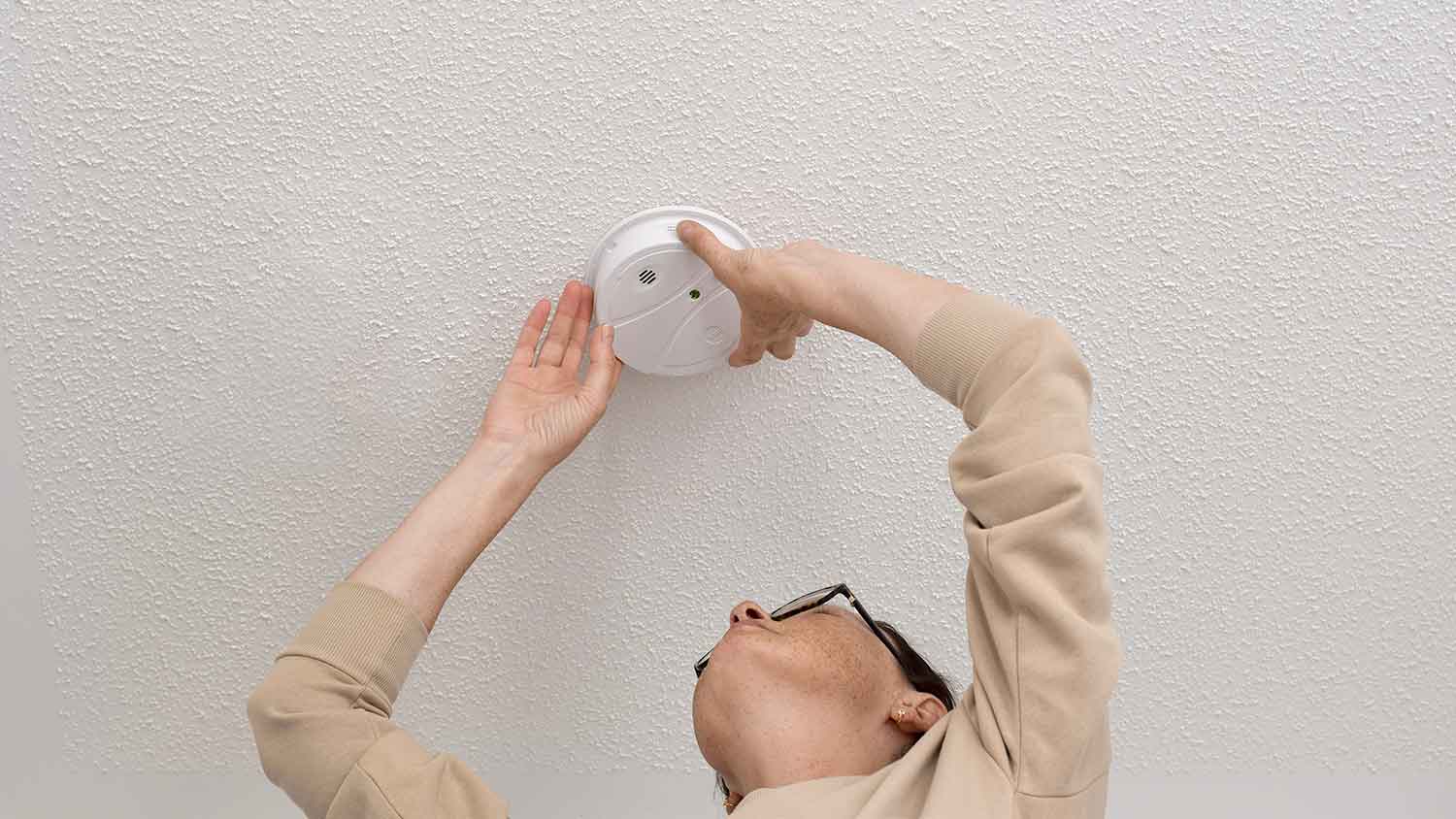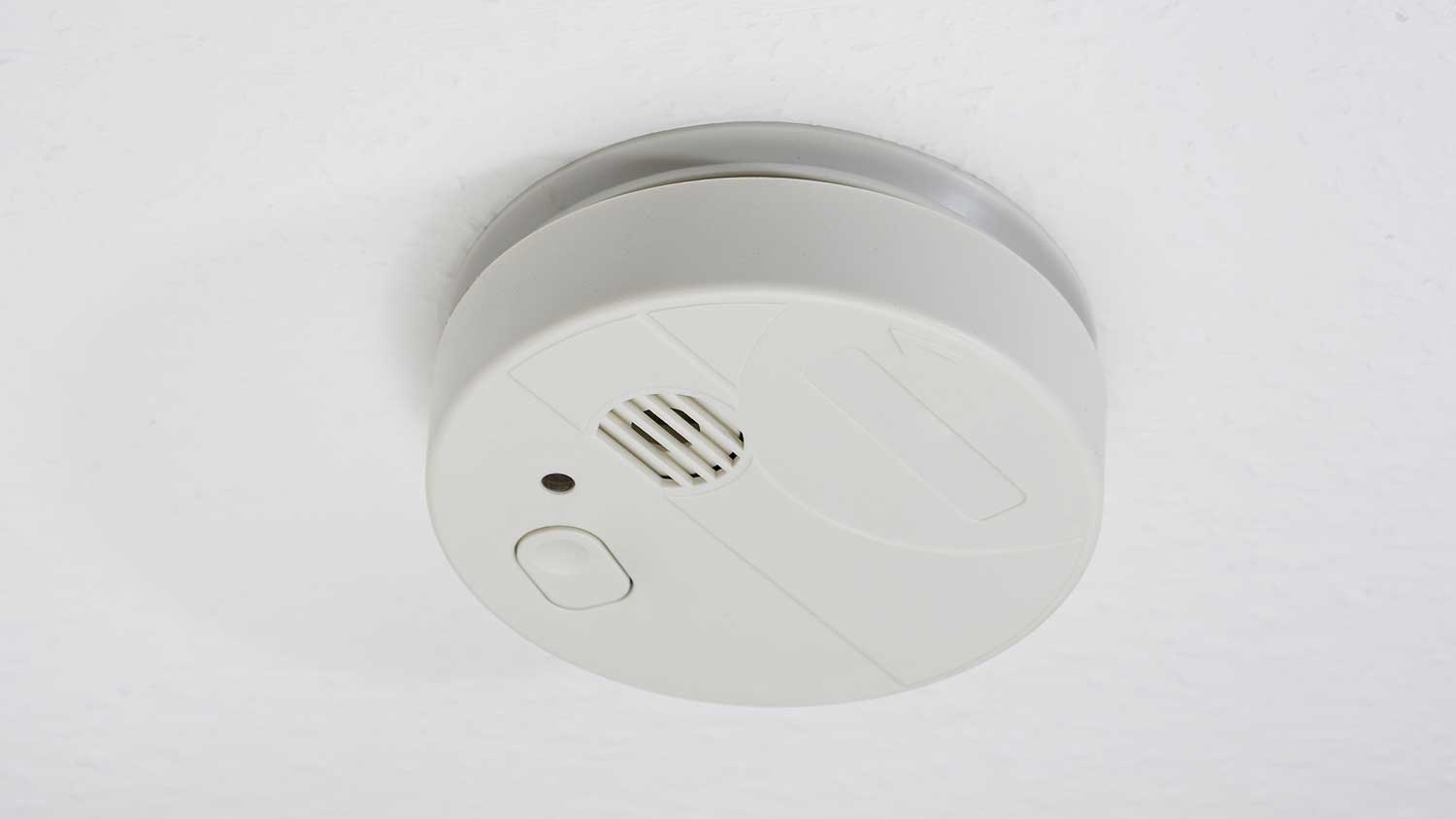
How much does it cost to install a doorbell camera? It depends on whether you plan to DIY or hire a pro. Learn about different models and their power sources, too.
For a safer home, install both types of detectors


Carbon monoxide (CO) detectors detect carbon monoxide, an odorless gas.
Smoke detectors detect smoke from house fires, and all homes should have them.
Install CO detectors in homes with gas appliances or attached garages.
These alarms serve different purposes, so install both in your home.
You want to keep your family safe from home hazards, and installing carbon monoxide and smoke detectors is an easy, proactive way to do that. While these devices are similar, each one alerts you to a different danger. This guide covers the differences between carbon monoxide detectors and smoke detectors and the pros and cons of each option.
Simply put, carbon monoxide detectors sense carbon monoxide from gas-producing appliances and machinery, while smoke detectors sense smoke from fire and flame. While they’re both safety alarms and seem similar at first glance, they function differently and keep your family safe from different dangers. So, consider installing both in your home rather than choosing between the two. Below are the pros, cons, and options for each so you’re prepared before purchasing them.


Carbon monoxide, or CO, is a colorless, odorless gas generated by vehicles, gas stoves, fireplaces, furnaces, and other appliances. When people and animals inhale it, they can develop carbon monoxide poisoning. CO detectors sense and monitor carbon monoxide levels in the air. The U.S. Environmental Protection Agency (EPA) recommends installing a CO detector on each floor of the home.
When levels exceed safe amounts, the detector’s alarm sounds.
There are two types of carbon monoxide detectors, and each works differently:
Electrochemical Sensors: This type of sensor uses a chemical solution that reacts with carbon monoxide to produce an electrical current. When the CO in the air gets too high, the electrical current rises and triggers the alarm.
Metal Oxide Semiconductors: These sensors contain heated tin oxide that interacts with carbon monoxide. Too much CO will change the tin oxide’s electrical resistance, and the alarm will sound.
| Pros | Cons |
|---|---|
| Alerts homeowners to carbon monoxide, a dangerous gas | Doesn’t sense fire or smoke |
| Last 5–7 years | Requires maintenance and replacement |
| Provides early warnings | Can set off a false alarm |
| Most are easy to install | Hardwired units may require professional installation |
Best for:
Bedrooms and sleeping areas
Homes with gas appliances, wood or gas fireplaces, or near doorways to attached garages
In any garage with idle vehicles
Placement on the wall instead of on the ceiling, as CO mixes evenly with air particles rather than rising like smoke
Carbon monoxide detectors monitor CO levels in your home and provide around-the-clock warnings. They alert you when carbon monoxide reaches unsafe levels so you’ll know to evacuate your home and call for help to find the source of the gas.
This is essential for homeowners who:
Use fireplaces or gas appliances
Have attached garages or furnaces that run on natural gas, propane, or oil
Have personal risk factors like chronic heart disease or breathing problems
Most CO detectors last between 5 and 7 years before you have to replace them.
Carbon monoxide detectors sense dangerous levels of CO, but that’s all they do. They won’t sense fire, smoke, or other dangers. You can pair them with smoke detectors for more complete protection.
They also require basic maintenance, including battery replacement (for battery-operated models), sensor cleaning, and routine testing. In some cases, they can issue false alarms, especially if they’re near kitchens, garages, or fireplaces. Most are easy to install, but if you choose a hardwired system, you may need to call a local electrician.

Smoke detectors sense smoke from fires to alert homeowners to danger. Most are very sensitive, so they can give the earliest possible warning to let people and pets evacuate and leave time for fire suppression efforts.
There are two types of smoke detectors:
Ionization Smoke Detectors: Ionization detectors use a small amount of radioactive material to ionize the air inside the detector. Smoke stops the ionization process, triggering the alarm. These detectors are best for fast-happening fires with many flames.
Photoelectric Detectors: Photoelectric detectors have a light beam that shines into a sensor. When smoke particles enter, they disrupt and scatter the beam and sound the alarm. These are best for smoldering fires.
The National Fire Prevention Association recommends having both types of detectors in your home, as it’s impossible to predict which type of fire is more likely to occur.
| Pros | Cons |
|---|---|
| Detects smoke and fire | Only detects smoke, not gasses |
| Low-maintenance | Requires maintenance and replacement |
| Lasts about 10 years | Can set off a false alarm |
Best for:
All homes, commercial buildings, and public buildings
Inside or just outside bedrooms
Basements, attics, and areas where you might not see fires start
Near fire-prone areas: kitchens, fireplaces, heaters, and electrical outlets
Placement on ceilings rather than walls or lower locations, as smoke rises
Smoke detectors are a key part of keeping your home and family safe. They give you a heads-up when smoke is present so you can get to safety and call emergency personnel to start fire suppression efforts. The National Fire Protection Association (NFPA) emphasizes the role of advance warning from smoke alarms in evacuating the home and recommends having a fire safety plan in place.
The American Red Cross also recommends knowing how to operate a fire extinguisher, getting out of the home and staying out, and calling 911 or your local emergency center.
Most smoke detectors require no maintenance beyond battery replacement and monthly testing. On average, expect your smoke detectors to last about 10 years before you need to replace them. They come with various options, such as types of sensors, voice and sound alerts, and battery-power or plug-in and hardwired models. You can also install them as part of a fire suppression system, such as fire sprinklers.
Don’t place smoke alarms too close to fans or air ducts when mounting them. Moving air can displace smoke from the sensor. You also don’t want your alarms right by the kitchen stovetop or bathrooms. Smoke from cooking and steam from a shower can set off an alarm.
Like CO detectors, smoke detectors complete a single task—detecting smoke particles—so they don’t detect carbon monoxide or other gases. They’re low-maintenance but require some attention (like testing and new batteries) and eventual replacement. Test your smoke detectors monthly and replace them when they stop alerting.
Smoke detectors are sensitive to smoke particles in the air and may also alert to heat and flame. Although this is a good feature in an emergency, you may get false alarms from smoke during cooking, excessive heat or smoke from wildfires or pollution, steam from showers, and other non-emergency situations.

Now that we’ve looked at the pros and cons of the two types of detectors, let’s see how they compare in some significant areas.
Smoke detectors are small, round, and white or neutral in color. They can be placed on a ceiling where smoke will rise. Their size, color, and location make it easier to install them where they’ll blend in. On the other hand, CO detectors tend to be larger and bulkier, come in various shapes, and are mounted on a wall, so it can be harder to hide them.
Both types of detectors have a range of features. They may have digital displays, voice alarms, hush buttons, dual sensors for smoke and CO, and some interconnect with smart home devices. Review your options to find models with the right combination of customizations for your needs.
The average smoke detector costs $10 to $50, and the average CO detector costs between $20 and $100, depending on the type and available features. Look carefully at specific models and their features to help you determine which offers the best value and the most protection.
Smoke and carbon monoxide detectors come in battery-operated, plug-in, and hardwired units, so they’re equally easy to install, depending on the type of power source you choose. Battery-operated units and plug-in models are straightforward. You simply choose the location, install the unit with a few screws, or plug the unit into an outlet. Hardwired units require more effort and professional skill, so hire a licensed electrician for the installation.
Both detectors need new batteries (if they’re battery-operated models), regular testing, and occasional sensor cleaning. However, besides minimal maintenance, there isn’t much you’ll need to do with either type of detector. However, smoke detectors tend to last longer and have longer intervals between required maintenance tasks, so they’re lower maintenance than CO detectors.
Smoke detectors last about 10 years, while carbon monoxide detectors last 5 to 7 years. They’re made to be durable in normal household conditions. While their longevity is similar, smoke detectors have a bit of an edge due to their slightly longer life span.
It’s hard to judge the return on investment from home-hazard detectors. After all, you can’t put a price tag on the safety of your family or home. However, while many states have laws requiring smoke detectors in all residences, fewer states require carbon monoxide detectors. For this reason, CO detectors are an added safety feature that can show buyers you have invested in the overall safety of the property.
Smoke detectors might appear to have the upper hand when comparing both types of alarm units, but the real-life answer isn’t either-or—it’s both. Since smoke alarms and carbon monoxide detectors protect against different dangers, install both in your home. Choose the right type of detectors for your home’s features and place them in the recommended locations to get the best safety coverage and early alerts in case of a fire or increased CO levels.
You can buy combination carbon monoxide and smoke detectors, sometimes called two-in-one or three-in-one (smoke, fire, and carbon monoxide) alarms. These have sensors to detect CO and smoke and serve a dual purpose. Many have separate lights and different alarm sounds to indicate which danger is present.
If you buy a combination CO and smoke detector, you won’t have to install or maintain multiple detectors. A combination unit may also be better for smaller living areas since a single detector takes up less space than two separate units. Buying a single detector that performs both tasks can save space, look less cluttered, and still effectively provide early warnings.
On the other hand, deciding where to place a dual-function detector in a larger area can be challenging. The ideal location for both detectors differs, so combining them into one unit can make it difficult to choose a location where both sensors are at the right height and near high-risk areas. While you’ll need both near sleeping areas, smoke detectors work best on ceilings, whereas CO detectors work best on walls—and you’ll need them near fireplaces or gas appliances.
From average costs to expert advice, get all the answers you need to get your job done.

How much does it cost to install a doorbell camera? It depends on whether you plan to DIY or hire a pro. Learn about different models and their power sources, too.

Feeling safe at home should always be a priority, and installing a new security system can help you do just that—no matter where you live.

Motion-sensor lighting costs vary greatly because they have so many customizations available. Learn more by using this cost guide about motion-sensor lights.

A home alarm system can help make your home safer, but it depends on several factors. Keep reading to see if home alarm systems are worth it.

Discover home fire sprinkler system costs, including installation, maintenance, and key cost factors. Learn how to budget and save on your home fire protection.

There are many different avenues for how to secure windows. Depending on your home’s layout and vulnerabilities, one or more of these six tips may help.